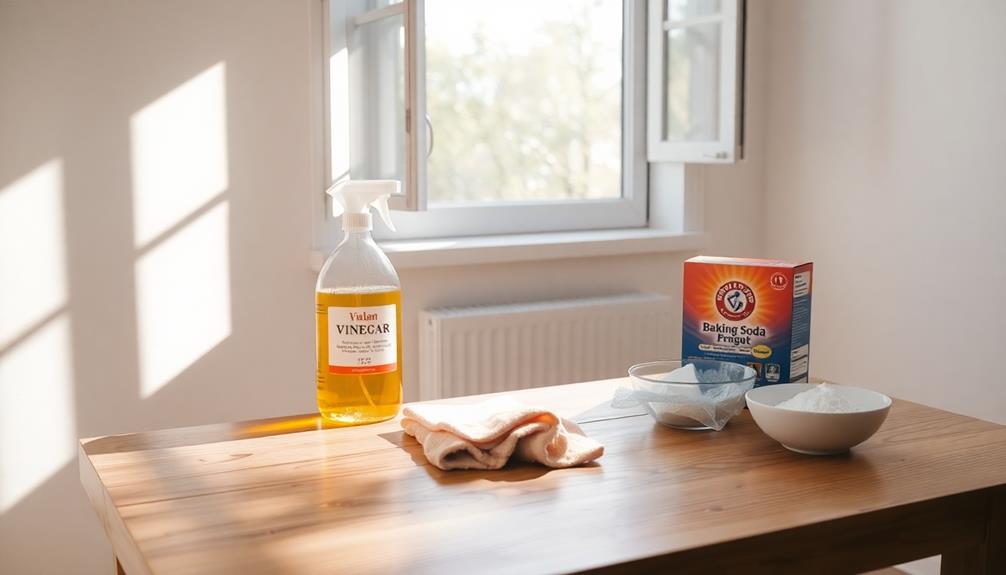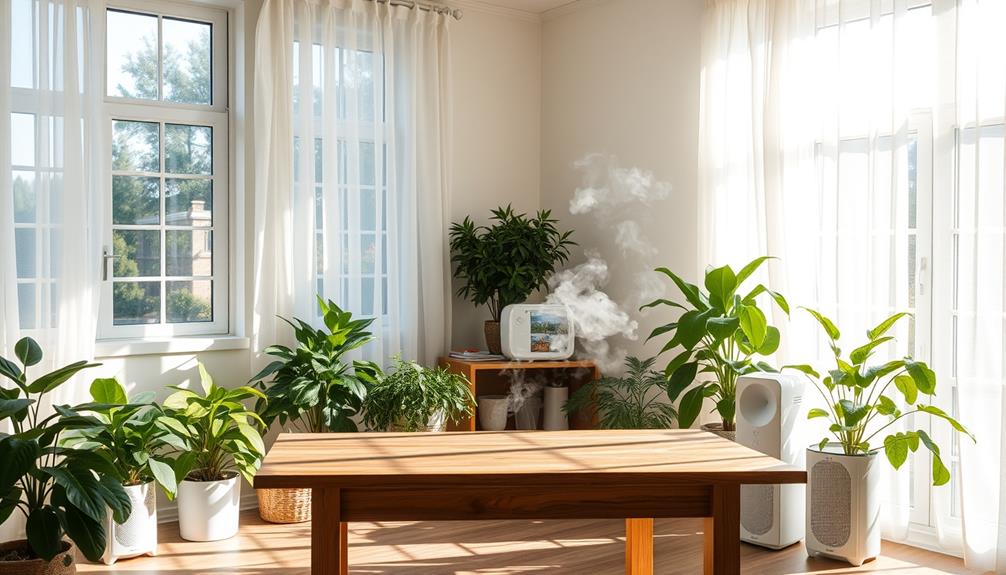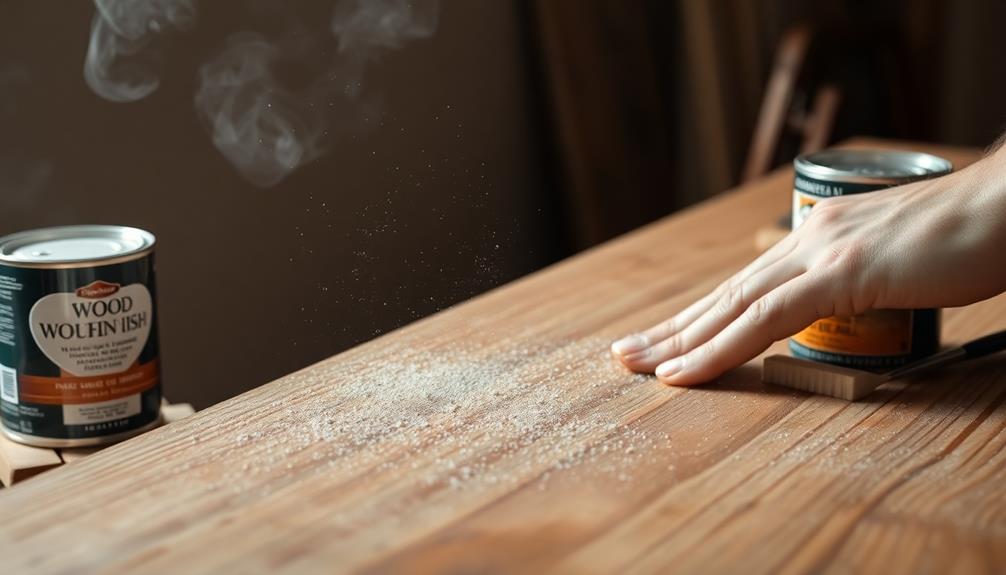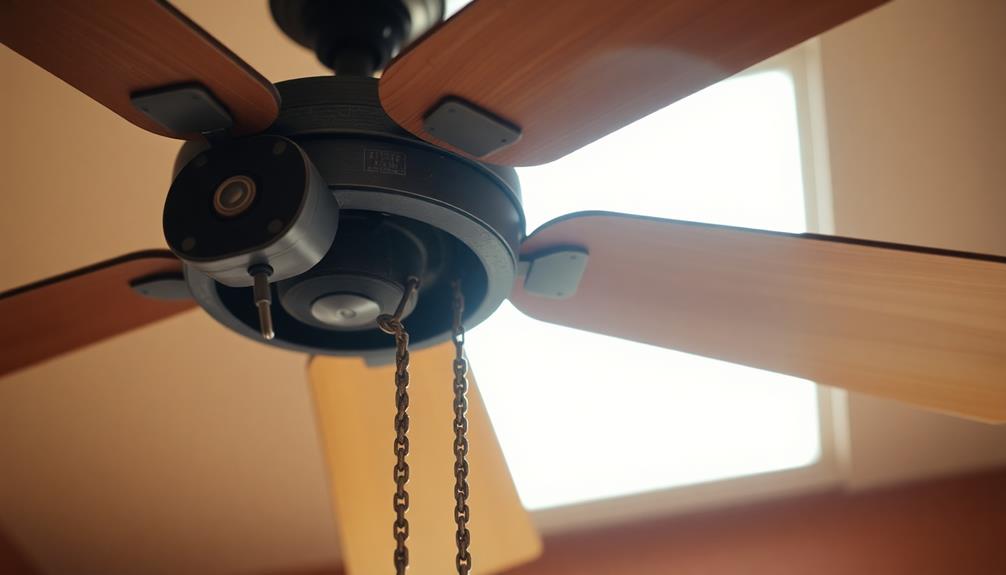To eliminate the smell of smoke from wood furniture, begin by wiping surfaces down with a blend of vinegar and water. For more persistent odors, baking soda works wonders; spread it over the furniture and allow it to sit for a couple of hours. Clean nicotine residues with diluted dish soap. After cleaning, ventilate the furniture in a shaded spot for several hours. You may also place activated charcoal in bowls close by to soak up any remaining smells. If the odor remains, refinishing may be required. Continue to search for additional advice and methods that can aid in rejuvenating the freshness of your furniture.
Key Takeaways
- Clean surfaces with a vinegar and water solution to neutralize smoke odors effectively.
- Use baking soda as an odor absorber by letting it sit on surfaces for several hours.
- Air out furniture outdoors in a shaded area to allow fresh air to dissipate smoke smells.
- Consider refinishing the furniture if odors persist after thorough cleaning efforts.
- Implement preventive measures like using air purifiers and regular cleaning to minimize smoke odor buildup.
Understanding Smoke Odors in Furniture
When it comes to wood furniture, understanding smoke odors is vital, especially since these smells can linger for years. The porous nature of wood allows smoke particles, particularly from cigarette smoke, to penetrate deeply into the material. This means that simply wiping down the surface won't effectively remove smoke smells.
Different types of smoke, like tobacco, fire, and even cooking smoke, leave behind unique, persistent odors that require specific cleaning methods to tackle. In addition, taking preventative measures to protect your furniture from smoke damage in the first place can save you time and effort later on, such as using tick repellents to avoid unwanted exposure.
Identifying the source of the smoky odor is essential for effective treatment. If you don't address the deeper, absorbed odors, you might find that the smell returns even after cleaning.
Furthermore, vintage and antique furniture may require extra care during the removal process, as the age and materials can complicate your efforts.
Understanding how smoke odors interact with wood furniture helps you prepare for a more thorough cleaning. By recognizing the challenges posed by smoke damage, you can take the necessary steps to refresh your furniture and eliminate unwanted smells, ensuring a cleaner and healthier living environment.
Initial Cleaning Techniques

Removing smoke smells from wood furniture starts with some straightforward initial cleaning techniques. First, you'll want to clean the wood thoroughly.
Mix equal parts of vinegar and water in a spray bottle, and wipe down the surfaces repeatedly. This solution can help reduce smoky odors effectively. For a more natural approach, consider using safe snacks for hamsters as they also highlight the importance of avoiding harsh chemicals that could potentially harm the wood finish.
Next, consider using baking soda, a powerful odor absorber. Sprinkle it generously on the affected areas of your furniture and let it sit for several hours or overnight. Once it has had time to work its magic, vacuum it up to eliminate the smoke smell.
For stubborn nicotine residue, dilute Dawn dish soap in warm water and scrub the wood's surface thoroughly. This will help break down any lingering grime. If you prefer a more traditional cleaner, Murphy Oil Soap is a popular choice for wood furniture. Just keep in mind that its strong scent may require additional deodorizing.
Throughout this cleaning process, it's crucial to perform multiple rinses and change the water frequently. These initial steps will set you on the right path to eliminating smoke odors from your beloved wood furniture.
Airing Out the Furniture

After you've cleaned your wood furniture, airing it out can be a game-changer in eliminating smoke odors. To maximize the fresh air exposure, place the furniture outdoors in a protected area. This allows the fresh air to circulate around the piece, greatly reducing the smoke smell.
Consider using non-toxic cleaning solutions to further enhance your efforts in removing lingering odors. Just remember to avoid direct sunlight during this process, as it can warp or fade the wood.
If you can't air it out outside, using a fan indoors can still improve airflow and help dissipate those lingering odors. Ideally, you should aim to air out your furniture for several hours to multiple days for best odor reduction.
Regularly monitor the furniture to verify it remains in a safe environment, free from moisture and excessive heat.
Utilizing Odor-Absorbing Substances

To effectively tackle smoke odors in your wood furniture, try using activated charcoal and baking soda.
Activated charcoal's absorbing power can neutralize persistent smells when placed in bowls inside your furniture.
Meanwhile, sprinkling baking soda generously on surfaces and letting it sit for several hours can help eliminate any lingering scents.
Activated Charcoal Benefits
Activated charcoal's remarkable ability to absorb odors makes it an invaluable ally in tackling stubborn smoke smells trapped in wood furniture. This powerful, porous material effectively binds to and neutralizes smoke odor, offering a lasting solution that outperforms typical air fresheners.
Here's why you should consider using activated charcoal:
- Highly Effective: It can absorb the smoke and eliminate the smell, ensuring fresh air in your home.
- Non-Toxic Option: Safe to use around pets and children, activated charcoal provides peace of mind while combating odors.
- Easy Application: Simply place bowls of activated charcoal inside drawers and shelves to considerably reduce persistent smoke smells over several days.
To maximize its effectiveness, remember to regularly replace or refresh the activated charcoal. This simple step will enhance its odor-absorbing capabilities, helping you achieve ideal results in removing the smoke smell from your wooden furniture.
With activated charcoal, you're choosing a natural, efficient method to restore the freshness of your living space.
Baking Soda Applications
Baking soda is a powerful ally in your battle against smoke smells in wood furniture. This highly effective odor absorber neutralizes smoke odors when you sprinkle it generously over the affected surfaces.
For best results, let the baking soda sit for several hours or even overnight. Make sure to cover the furniture completely and consider flipping or rotating it to treat all sides.
After the waiting period, you'll need to carefully clean up the baking soda using a mini brush and dustpan. This prevents clogging your vacuum. Once you've removed most of the baking soda, vacuum the area thoroughly to guarantee no residue is left behind.
Baking soda works by chemically interacting with smoke particles, drawing them out of the wood's porous surface without damaging the finish.
You can enhance this method by combining it with other cleaning techniques, like vinegar solutions or commercial odor removers, for even better smoke smell removal.
With persistence and the right approach, baking soda can effectively help you reclaim the freshness of your wood furniture from lingering odors.
Refinishing as a Last Resort

If you've tried everything and smoke odors still linger, it might be time to contemplate refinishing your wood furniture.
This process involves stripping away the old finish to eliminate stubborn smoke particles and applying a new coat to protect against future odors.
Before you start, make sure to evaluate the wood type and extent of damage, as some pieces may need professional help.
When to Refinish
Refinishing your wood furniture should be a last resort when all other cleaning methods fail to eliminate stubborn smoke odors. If you've tried various techniques to remove the smoke and still notice lingering smoke smells, it might be time to contemplate refinishing. This process strips the wood down to its bare surface, effectively removing layers that have absorbed smoke particles and odors.
Before you engage in refinishing, evaluate the wood type and assess the extent of smoke damage. Here are some signs that refinishing may be necessary:
- Deeply ingrained smoke smells persist even after thorough cleaning.
- The furniture shows visible signs of damage or wear from smoke exposure.
- You've exhausted all other cleaning options without success.
Choosing professional refinishing services can be beneficial, especially for valuable antiques or heirlooms. They'll guarantee your smoky furniture receives the care and precision it needs during the refinishing process.
Refinishing Process Overview
When smoke odors cling stubbornly to your wood furniture, the process of refinishing can help you wipe the slate clean. This last resort involves stripping away the existing finish and any layers that have absorbed smoke smells, providing a fresh surface to work with. Here's a brief overview of the refinishing process:
| Step | Description | Tools Needed |
|---|---|---|
| 1. Assessment | Check wood type and smoke exposure | None |
| 2. Stripping | Use a chemical stripper to remove old finish | Stripper, brush |
| 3. Sanding | Sand down the furniture to eliminate smoke-affected wood | Multiple grits of sandpaper |
| 4. Cleaning | Wipe down the surface to remove dust | Cloth, cleaner |
| 5. Finishing | Apply a new finish (polyurethane or varnish) | Brush, new finish |
Sanding is important and may require multiple grits for best results. After you finish sanding, applying a new finish seals the wood and prevents future odors from penetrating. Remember, refinishing can be labor-intensive and might alter the original character of your furniture, so always consider it a last resort. Before starting, ensure the surface is clean and free of dust or debris, as this will help the finish adhere properly. If you’re wondering **how to paint laminate furniture**, it’s important to first use a high-quality primer designed specifically for slick surfaces to ensure the paint sticks. Patience and careful preparation are key to achieving a professional and lasting result.
Preventive Measures and Maintenance

Regularly maintaining your wood furniture is essential to prevent smoke odors from becoming a permanent fixture. By taking a few preventive measures and committing to consistent maintenance, you can keep your furniture smelling fresh and clean. Here are some effective strategies:
- Ensure proper ventilation: Keep windows open or use exhaust fans to minimize smoke accumulation.
- Use odor absorbers: Incorporate baking soda or vinegar during your regular cleaning routine to combat smoke odors.
- Apply a protective finish: Consider using matte polyurethane to repel smoke absorption and protect the wood's integrity.
Additionally, regularly clean your furniture and textiles to reduce smoke particle buildup.
Air purifiers with HEPA filters can effectively capture smoke particles in your home, preventing them from settling on surfaces.
Store furniture in smoke-free environments, and place activated charcoal or coffee grounds in drawers and cabinets to absorb lingering odors.
By taking these steps, you'll maintain a fresher atmosphere and extend the life of your wood furniture.
Frequently Asked Questions
How Do You Get Cigarette Smoke Smell Out of Wood Furniture?
To tackle cigarette smoke smell, start by cleaning surfaces with equal parts water and vinegar. You can also use baking soda to absorb odors, and consider placing activated charcoal in drawers for lasting freshness.
How Long Does It Take for Smoke Smell to Leave Wood Furniture?
You might think getting rid of smoke smell is like waiting for a glacier to melt! It usually takes days to weeks, depending on the odor's intensity and the methods you use to tackle it.
How to Remove Smells From Wood Furniture?
To remove smells from wood furniture, start by cleaning with water and vinegar. Then, sprinkle baking soda on the surfaces. Consider using activated charcoal or commercial odor removers for more stubborn odors that linger. Allow the furniture to air out in a well-ventilated area for several hours or even days if possible. For persistent smells, repeat the cleaning process until the odors dissipate completely. If you’re specifically wondering how to remove dog odor from wood furniture, placing bowls of white vinegar or coffee grounds nearby can help absorb the remaining scent over time.
Will Smoke Smell Eventually Go Away From Couch?
Imagine a friend's couch soaked in smoke for years. Over time, the smell might fade slightly, but it often lingers without proper cleaning. You'll need to deep clean or use odor-neutralizing sprays for better results.
Conclusion
In the battle against smoke odors in your wood furniture, it's important to act decisively. By using the right cleaning techniques, airing out your pieces, and employing odor-absorbing substances, you can reclaim your furniture's freshness. If all else fails, refinishing might be your best bet. Remember, an ounce of prevention is worth a pound of cure—regular maintenance can keep those odors at bay for good. Take these steps, and you'll breathe easy in no time!









